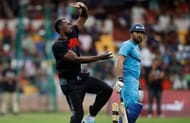"This is a piece of fiction written for humorous purposes and should be taken in jest."The West Indies have been struggling in international Cricket for quite some time now. Barring the occasional flashes of brilliance, akin to their World Twenty20 triumph in 2012, they really haven’t dished out anything worthy to write home about.The Australians in particular, have been severe on them this past year. Under Michael Clark, they posted wins by 9 wickets and 277 runs respectively in the two test matches in the Caribbean. And in the Australian summer, Steven Smith took over and with a band of chirpy youngsters handed a clueless pack of West Indians an almighty spanking that won’t be forgotten in a hurry.That the West Indies team is in turmoil would be an understatement. Their young yet talented skipper constantly roots for fairer wages while their coach laments the unavailability of star players. And on the field, their players just aren’t able to sustain the tempo long enough to put up a fight in the longer version of the game.The West Indies are now but a shadow of their illustrious and world-beating ancestors. And as their Cricket Board huddles up to find ways and means to inject life into their system, I did some brainstorming of my own. Given that the challenge on hand is out of the ordinary – remember, we’re literally trying to grow cricketing arms and limbs back again – the remedial measures ought to be equally path-breaking.So I took the path less traversed and conjured up five ideas that can be summoned up should all else in the routine mold of “tried and tested” fail.
#5 Turn Usain Bolt into a lean, mean fast bowler

So Usain Bolt might just hang up his spikes after the Rio Olympics this year. He would have just turned 30 and with millions stashed away in the bank, he can walk away into the sunset as the most decorated athlete of all time. What a pity - some might say – for he would still have the muscles to chug along a bit longer.
Headlines might even call the event “the day athletics died”. Just as obituaries start trickling in for track and field, why not cash in on all the time that Bolt will have to spare having quit sprinting. Has anyone thought of draping him up in white, handing the man a leather ball and turning him into a West Indian test cricketer?
What an event that would be. While the world of athletics mourns, Cricket would rejoice and West Indies in particular. Let’s just give life to this far-fetched thought for one fleeting moment.
It’s been well documented that years before stunning the world with his electric speed, Bolt played Cricket as a pace bowler. At 30 and presumably having just finished another successful Olympic campaign, the Jamaican would undoubtedly be in great physical shape. Bowling lessons and a few weeks in the nets and you never know – we might just have ourselves the fastest bowler in the world.
And what a revolution that would spur. A home series against a visiting Afghanistan side could feature Bolt making his debut to a packed Sabina Park. The crowds would sit on each other’s laps and crawl upon one another to get a glimpse of the sprinter turned cricketer.
The broadcasters and advertisers would queue up to buy rights and slots for the telecast. Corporations would wage a battle to have their logos printed on the shirt that would flutter in the mini-dust storm that Bolt would stir up as he chases a ball down to long-off. And needless to say, the struggling West Indian Cricket Board would lap up the sudden deluge of cash with glee to fill their coffers.
Bolt himself would perhaps love the idea. He has for long professed his love for other sports and football in particular while hinting at the latter as a possible post-retirement pastime. While his memory is still fresh, someone ought to entice him with a Cricket-bug.
He could simply amble up to the crease and with an innocuous action, conjure up some serious pace. With the occasional effort-over, he could surely have the batsmen paying attention to their headgear while strapping up. And he could make a jolly good outfielder as well. Like a cheetah, he could make a boundary-raiding look more like a jog on the beach.
With Bolt playing Cricket, the ripple effects would be felt across the Caribbean islands. Boys would trade their spikes for pads and fast-bowling would be back in vogue again. Cricket would climb up the popularity ladder once again and “sprint factories” would turn into factories churning out fast bowlers.
Usain Bolt could just be the catalyst that West Indies Cricket needs. A messiah that could lead them out of the doldrums. If he could show the Jamaicans that they could sprint their way out of poverty, he might as well do to their Cricket what the movie Cool Runnings did to the sport of bobsleigh in Jamaica.
#4 Create a West Indies friendly pitch for all their international games

Pitch reports make for fascinating viewing. The mic-wielding commentator, akin to a high school chemistry teacher, attempts to decode the diverse components that make up the composition of a 22-yard stretch that would determine the player’s fate on the day.
And every time the pitch-shrink recognizes a “belter of a pitch”, he is almost compelled to say that the batsmen would love to carry it in their back pockets while on tour.
Now the West Indies have a batting and bowling problem. Fixing both of those is a challenge as complex as getting Louis Van Gaal off his chair and to the touchlines during a Manchester United game.
So I figured, why not throw the Caribbean batsmen a lifeline and have pitches tailor-made to suit their batting – regardless of where they play. This way, the opposition will at least have a decent total to chase (that’s assuming Marlon Samuels & Co decide to make use of the conditions).
Even better, they could be allowed to prepare a pitch of their dreams and have it loaded on a trailer. So regardless of the venue, this “West Indian dream-pitch” can simply be dropped in to kick start a game. And I am sure, the opposition would completely understand that this is for a very noble cause indeed.
The test playing nations could even lobby for the ICC to lay down a legislation to this effect – all done with the single goal of saving West Indies Cricket.
With a batting friendly pitch favouring the West Indies, Steven Smith will finally have a challenging total to chase and Gary Sobers will, after decades, witness his country sending the opposition on a leather-hunt.
#3 Auction player-spots in the West Indies team

There’s a reason why Barcelona, Real Madrid and Bayern Munich play an exciting brand of football. Each of those sides contains magical ingredients and are brought to the boil by a super chef that alters the taste to suit the banquet.
In Cricket, the IPL, Big Bash League and other Twenty20 leagues across the world offer similar mouth-watering opportunities to put together “dream teams” - ensembles that could take down a national side on any given Sunday.
Then why not do the same with the West Indies Cricket team?
No, I am not asking for the creation of a Twently20 league in the region – they already have the Caribbean Premier League (and that’s how Shoaib Malik got back into the Pakistan team). What I am proposing is an ICC approved development project of sorts to rescue the slow-death that West Indies has condemned itself to. This would be much like the UN that coughs up development schemes to rescue impoverished countries in Africa.
Here’s how this would work.
All the test playing countries would sign up to pay the West Indies Cricket Board (WICB) and in return secure a test match spot for one of their stars (players that are good enough to play test Cricket but, unfortunately, can’t make it to their own national sides as all spots are taken. Pity!)
And the WICB, under the ever watchful eye of an ICC watchdog, decides everything - the number of spots that it chooses to outsource, the cricketing genre (ODI/ Test/ Twenty20) and the contract duration
Now there’s every possibility that the boards of every test playing nation would oppose the funding of this ludicrous idea, so the ICC takes a leaf out of the F1 book. The players would be permitted to raise their own finances through sponsorship. Once they raise a pre-determined threshold amount, they are up for grabs.
Once bought, these players turn out in West Indian colours. The benefits are several. A deserving player gets to play international Cricket, the WICB makes money and if all goes to plan, the team wins enough games to reclaim the trust of their countrymen and in the process, West Indian Cricket lives to fight another day.
#2 Bring back Allen Stanford

“We will never forget what he did for the Caribbean in terms of bringing back the interest in cricket". This was Darren Sammy talking to a BBC correspondent while reminiscing about the cash-rich Twenty20 tournaments that Allen Sanford organized between 2006 and 2008.
Allen Stanford used to be a billionaire from Texas that held an Antiguan citizenship. Having made his fortune in real estate and later in financial services, he decided to diversify. He now desired to be the Kerry Packer of the Caribbean and sought to do something radical with Cricket in the region.
So he created his own Cricket stadium, poured in his own cash, created the Stanford 20/20 tournament, flew into Lords in his private helicopter and displayed a treasure-trove of $20 Million as prize money for a winner-takes-all finale between a Caribbean side and an English XI.
The 20/20 tournament, Darren Sammy claimed, was a success. Players were motivated owing to the money and the coverage was watched by a global TV audience. And if the locals are to be believed, the atmosphere evoked was so infectious that it put the World Cup in 2007 to shame. More importantly, the kids were playing Cricket again instead of sprinting down a 100-meter lane.
Allen Stanford is now serving an 110-year prison term for fraud and other financial misdemeanors. It was a shocking fall from grace for the billionaire businessman, much like the change in fortunes that West Indies Cricket has been witnessing since the mid-nineties.
For having promised so much and delivered but the tip of an iceberg, Stanford ought to be condemned to hard labour. Not in the quarries, but hard labour of a different sort – an attempt to rejuvenate Cricket in the Caribbean.
As a fundraiser, as a vocal promoter and as a recruiter of players, Stanford can play an ally to the West Indies Cricket Board just the way Leonardo Di Caprio did to the FBI in the movie Catch Me If You Can.
Already convicted and at the mercy of the FBI, Stanford could be tasked with rekindling the dwindling interest for Cricket at the grass-root level and quite simply, do his thing to bring the fizz back into the game in the region – under the close watch of authorities this time, though.
It’s surely a risk that West Indies can take. They barely have any money (they won’t have to worry about paying him) and their team is already an embarrassment (they couldn’t plummet any further). So recruiting Allen Stanford to work for them as an ally and picking his brains is surely a gamble worth considering to save their Cricket.
#1 An under-arm ball for the bowlers and an additional dismissal per innings for the West Indian top-order

Most bowlers in international Cricket would more than fancy their chances against the West Indian batsmen. Terms like resilience and resistance aren’t something that you would normally associate with them. Likewise, their present bowling attack is a far cry from those of the yesteryears.
And there’s enough fight between struggling batsmen to seek a promotion up the order when playing the West Indies. Just look at the scores that Usman Khawaja, Adam Voges and Shaun Marsh stacked up in the recent series. The trio will forever be indebted to Jerome Taylor & Co.
So given that the West Indians can’t quite conjure up unplayable deliveries at regular intervals to contain batsmen, the rules ought to throw them a lifeline. One under-arm ball per over. Try scoring off that! If Jason Holder’s men can somehow push the opposition to a “six runs off the final ball” equation in an ODI run chase, the probability of them winning would really skyrocket.
And to get to that stage in the first place, they need a decent score on the board, remember? Now how are we to aid them in that process given their lackluster batting form in recent times? You guessed right – given them an extra dismissal per innings as insurance.
The opposition is bound to cry foul for sure. The rules, therefore, will limit this insurance to just the top three West Indian batsmen per batting innings. They would be free to pick their top three that deserve this insurance-ticket and hope that at least one of them turns it into gold.
And just like all the other suggestions in this compilation, I am sure the magnanimity of the other Cricket playing nations would emerge. After all, protecting the legacy of West Indian Cricket is just as significant as promoting the ascendancy of Afghanistan. And if incarcerated no-ball offenders can be reinstated post-rehab, just how much harm can an under-arm ball do.
Cricket would get a new dimension and the West Indies, a new arsenal – all in the name of saving their Cricket from oblivion. And somewhere deep in the Australian outback, a certain Greg Chappell will feel vindicated.
Looking for fast live cricket scores? Download CricRocket and get fast score updates, top-notch commentary in-depth match stats & much more! 🚀☄️
